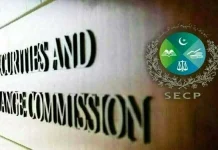The State Bank of Pakistan (SBP) has decided to keep the policy interest rate unchanged at 11 per cent, citing a worsening inflation outlook.
The Monetary Policy Committee (MPC) “noted that inflation in June 2025 decelerated to 3.2 per cent year on year, led mainly by lower food prices, whereas core inflation also declined slightly”, the State Bank of Pakistan (SBP) said in a statement.
However, the inflation outlook “has somewhat worsened in the wake of higher than anticipated adjustment in energy prices, especially gas tariffs”, it said. “Nonetheless, inflation is projected to stabilise in the target range going forward.”
The decision to keep the policy rate unchanged defied the expectations of trade and industry, with most analysts forecasting a 50-basis-point cut.
According to a Reuters poll conducted this week, all 15 analysts said they expected the SBP to ease, with nine forecasting a 50 bps cut, four predicting a deeper 100 bps reduction and two projecting a smaller 25 bps cut.
At 11pc, the real interest rate stands at 7.8 per cent higher than inflation, when excluding the 3.2pc inflation rate in June.
Central banks adjust interest rates to control inflation and stimulate or slow down economic growth. When inflation is too high, they may increase interest rates to make borrowing more expensive, which helps reduce spending and slow down the economy.
In contrast, when the economy is sluggish or inflation is low, they may decrease interest rates to encourage borrowing, investment and spending, boosting economic activity. These adjustments help maintain price stability and sustainable growth.
The SBP’s monetary policy statement said the impact of global trade tariffs remained uncertain, prompting central banks the world over to maintain their cautious monetary policy stance.
In view of the latest developments and potential risks, the committee assessed that the real policy rate should continue to be adequately positive to stabilise inflation in the target range of 5pc to 7pc.
The MPC noted that the trade deficit is expected to widen further in FY26 amid a pickup in economic activity and slowdown in global trade.
However, it reiterated that without structural reforms, it would be difficult to achieve higher growth on a sustainable basis. It stressed the need to continue the ongoing prudent monetary and fiscal policy mix to sustain macroeconomic stability.
SBP Governor Jameel Ahmad had previously said that sustainability was more important than economic growth, justifying a lower GDP growth of 2.6pc in FY25. He projected a GDP growth rate in the range of 3.25pc to 4.25pc for FY26, with State Bank’s foreign exchange reserves of around $17.5 billion by the end of June 2026.
The Monetary Policy Committee said the current account, which recorded a surplus of $2.1 billion in FY25, is expected to close the current fiscal year either at break-even or with a deficit of up to 1pc.
Moreover, workers’ remittances “are projected to grow at a slower pace amidst high base effect and recent rationalisation of home remittances incentive schemes”.
The SBP estimates remittance inflows to range between $38bn and $40bn this fiscal year compared to $38.3bn in FY25.
In the real sector, the SBP observed a gradual economic recovery, supported by significant year-on-year growth in automobile sales, fertiliser off-take, credit to the private sector and imports of intermediate goods and machinery. The improvement in high-frequency indicators is now reflected in the Large-Scale Manufacturing (LSM) data, which showed growth in both April and May after five months of contraction.
The central bank also highlighted improvements in the outlook for major crops, supported by better water availability due to recent rainfall. This positive trend in the commodity-producing sectors is expected to have a favourable impact on the services sector.
Despite achieving a 26pc increase in revenue, the SBP noted that the revised Federal Board of Revenue (FBR) target for the fiscal year was slightly missed. For FY26, the government aims for further fiscal consolidation, targeting a primary surplus of 2.4 per cent of GDP.
“Achieving this target will hinge on concerted revenue collection efforts and rationalisation of expenditures,” the SBP said.
Inflation outlook
While energy prices have remained lower on a year-on-year basis, recent upward adjustments in motor fuel prices and electricity tariffs are expected to drive energy inflation higher.
The SBP warned that energy prices could rise further, particularly due to the significant hike in gas tariffs, the phasing out of temporary reductions in electricity tariffs in the fourth quarter of FY25 and the recent increase in fuel prices.
The MPC emphasised that this outlook is “susceptible to multiple risks emanating from uncertain global commodity prices and trade outlook, unanticipated adjustments in administered energy prices, and potential widespread floods”.
Read also: Banking sector leads rebound
































